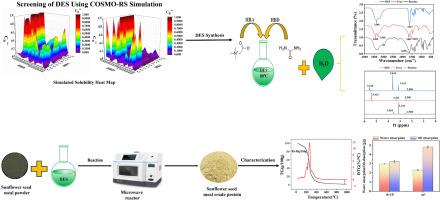基于cosmos - rs设计的葵花籽粕深层共晶溶剂的蛋白质提取与表征
IF 3.4
4区 化学
Q2 CHEMISTRY, MULTIDISCIPLINARY
引用次数: 0
摘要
本研究在真实溶剂类导体筛选模型(cosmos - rs)筛选的基础上,建立了一种微波辅助深层共晶溶剂(DES)提取向日葵粕(SM)蛋白的新技术。本研究首次对新型绿色DES萃取剂(甜菜碱-尿素)与传统碱溶酸萃取法在提取SM蛋白的效率、结构特征和技术功能特性等方面进行了系统比较。通过傅里叶变换红外光谱(FT-IR)和质子核磁共振(1H NMR)综合表征,证实了DES的成功合成。利用响应面法(RSM)阐明各参数之间的相互作用,建立预测模型,优化提取参数。优化后的甜菜碱-尿素(1:1 M比)DES体系表现出优异的性能,蛋白质回收率为89.17%,比传统碱溶酸提取法提高了31.71%。对比分析表明,与碱溶性酸提取的蛋白质相比,des提取的蛋白质具有更高的溶解度、乳化能力、保水能力、发泡性能和热稳定性。扫描电镜显示,在DES提取物更光滑的蛋白质表面,与食品应用的溶解度增强直接相关。这种环保的提取方法显著减少了化学废物的产生,同时保持了较高的提取效率,为SM蛋白的回收建立了有效的绿色方法。本文章由计算机程序翻译,如有差异,请以英文原文为准。

Extraction and Characterization of Protein from sunflower meal using tailor-made deep eutectic solvents based on COSMO-RS design
This work developed a new deep eutectic solvent (DES) extraction technique for sunflower meal (SM) proteins using microwave assistance, based on the Conductor-like Screening Model for Real Solvents (COSMO-RS) screening. The research represents the first systematic comparison between the innovative green DES extractant (betaine-urea) and conventional alkali-soluble acid extraction in terms of protein extraction efficiency, structural characteristics, and techno-functional properties of SM proteins. The successful synthesis of DES was confirmed through comprehensive characterization using Fourier-transform infrared spectroscopy (FT-IR) and proton nuclear magnetic resonance (1H NMR). The response surface method (RSM) was utilized to elucidate parameter interactions and establish a predictive model, leading to optimization of the extraction parameters. The optimized betaine-urea (1:1 M ratio) DES system demonstrated superior performance, achieving a protein recovery rate of 89.17 %, representing a 31.71 % improvement over conventional alkali-soluble acid extraction. Comparative analysis revealed that DES-extracted proteins exhibited enhanced solubility, emulsifying capacity, water-holding capacity, foaming properties, and thermal stability compared to alkali-soluble acid extraction counterparts. SEM revealed smoother protein surfaces in DES extracts, directly correlating with enhanced solubility for food applications. This environmentally benign extraction approach significantly reduces chemical waste generation while maintaining high extraction efficiency, establishing an effective green methodology for SM protein recovery.
求助全文
通过发布文献求助,成功后即可免费获取论文全文。
去求助
来源期刊
CiteScore
3.50
自引率
7.70%
发文量
492
审稿时长
3-8 weeks
期刊介绍:
The Journal of the Indian Chemical Society publishes original, fundamental, theorical, experimental research work of highest quality in all areas of chemistry, biochemistry, medicinal chemistry, electrochemistry, agrochemistry, chemical engineering and technology, food chemistry, environmental chemistry, etc.

 求助内容:
求助内容: 应助结果提醒方式:
应助结果提醒方式:


